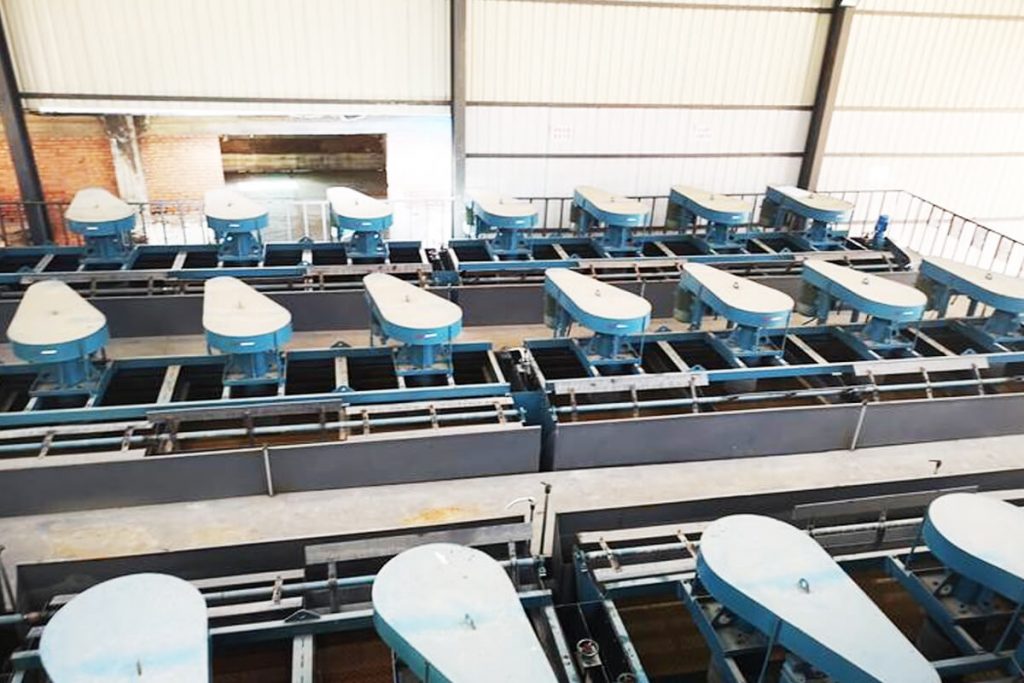Molybdenum ore is divided into three main types based on its mineral composition: molybdenite, molybdenite, and chalcocite. Molybdenite is the most common ore type that contains molybdenum disulfide, making it the primary source for molybdenum extraction. On the other hand, tungstenite is a lead molybdate mineral that typically forms bright orange to yellow crystals.
The main refractory molybdenum ores include high oxidation rate molybdenum ores, talc-containing molybdenum ores, carbon-containing or polymetallic, fine-grained or ultra-fine molybdenum ores, and molybdenum ores with complex structures.
Refractory molybdenum ore types
Separating molybdenum ores presents significant challenges: talc-type, high oxidation rate, and carbon-containing nickel. Most of these refractory molybdenum ores contain more than 0.08% molybdenum, which is above the industrial grade. Some molybdenum ores beneficiation contain more than 0.1% and are accompanied by valuable metals such as lead, gold, and silver, with specific development and comprehensive utilization values.
1. Talc-type molybdenum ore is a unique mineral resource with distinctive characteristics that distinguish it from other types of molybdenum ore. This type of ore is known for its talc-like appearance and texture and is typically found in fine-grained veins or sediments within the host rock. Talc impurities give the ore a soft, oily feel, making it easily distinguishable in mining operations.
2. High oxidation rate molybdenum ore, also known as fast-leaching molybdenum ore, is a unique mineral with exciting properties. This type of ore is highly reactive to oxygen and oxidizes rapidly when exposed to air or water. This causes the molybdenum to leach out of the ore quickly, making it easier to undergo the extraction process.
3. Carbonaceous nickel-molybdenum ore is a unique and valuable mineral deposit containing significant amounts of nickel and molybdenum, two essential elements in various industrial applications. Unique to this type of ore is the presence of carbonaceous material within the ore body, which makes processing more challenging but also adds economic value due to its high metal content. The carbonaceous nature of this ore affects the extraction process, as it may require specialized techniques to recover the necessary metals efficiently. When developing mineral beneficiation methods, it is essential to consider factors such as carbon content, mineral assemblage and host rock properties.
Refractory molybdenum ore beneficiation method

- Talc-type molybdenum ore beneficiation method
Talc-type molybdenum ore contains a certain amount of talc, and the floatability of the two minerals is very similar. The main beneficiation methods involve a combination of flotation and chemical leaching. This method effectively separates molybdenum minerals from gangue minerals to obtain higher molybdenum concentrations. Using specific reagents, such as collectors and frothers, in the flotation process can optimize the selectivity of molybdenum recovery while minimizing the loss of valuable minerals.
In addition, using advanced technologies such as high-pressure roller grinding (HPGR) during the crushing stage can enhance the release of molybdenum particles from the ore matrix. This improved release facilitates subsequent beneficiation processes, thereby increasing overall recovery rates.
- High oxidation rate molybdenum ore beneficiation
A two-stage flotation process is mainly used to improve the beneficiation of molybdenum ores with high oxidation rates. By flotating the sulfide minerals in the ore and re-floating the oxide minerals, this method can effectively separate and recover both types of minerals. The technology exploits differences in surface properties between sulfide and oxide minerals to improve molybdenum recovery.
Another strategy is to use new collectors explicitly designed for molybdenum oxide ores. These collectors are adept at selectively interacting with oxide minerals while minimizing their interaction with other gangue materials, thereby increasing separation efficiency.
- Carbon-containing nickel-molybdenum ore beneficiation method
The beneficiation of carbonaceous nickel-molybdenum ores mainly adopts a comprehensive method that combines pre-oxidation with advanced flotation technology. This process presents unique challenges, as the presence of carbonaceous materials impacts the recovery of valuable minerals. An innovative way to solve this problem is through pre-oxidation, which oxidizes carbonaceous materials before further processing. This not only improves mineral separation efficiency but also improves overall process economics by reducing reagent consumption.
Additionally, combining advanced flotation technologies such as froth and column flotation has shown promising results in separating carbon from nickel and molybdenum minerals. By optimizing operating parameters such as pH and particle size distribution, higher-grade concentrates can be obtained with minimal environmental impact. In addition, automated control systems can enhance process stability and ensure consistent performance throughout the beneficiation process.
The above mainly introduces the types of refractory molybdenum ores and the beneficiation methods of various refractory ores. Through the exploration of various methods such as acid leaching and flotation, the recovery rate of refractory molybdenum ore is mainly improved. Because ore types vary, JXSC supports you in customizing equipment and designing processes to unlock the full potential of molybdenum ore beneficiation.